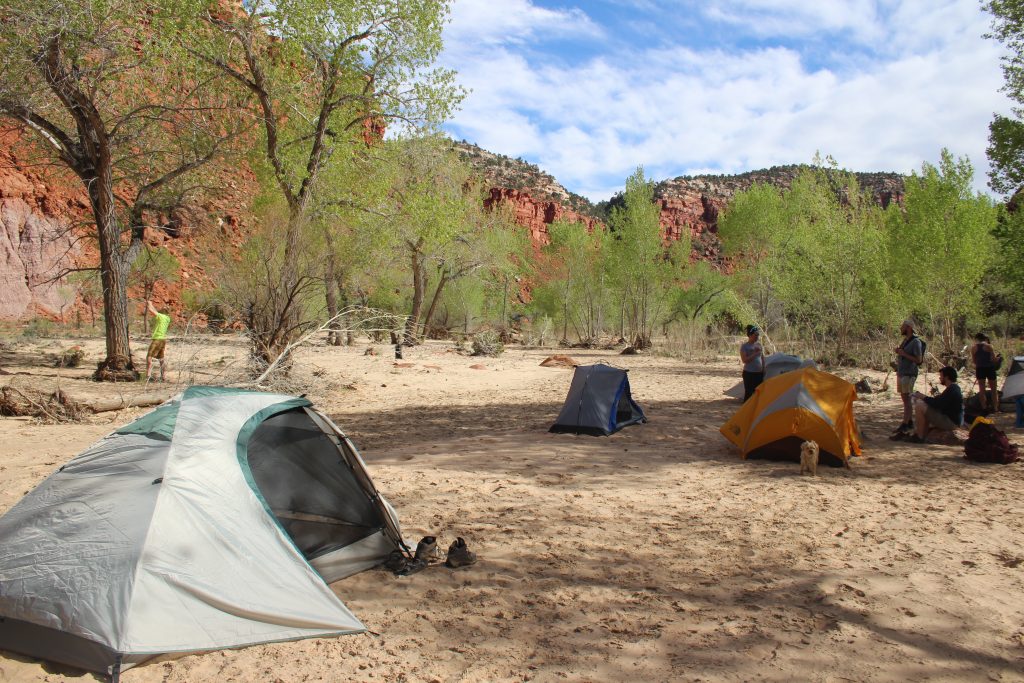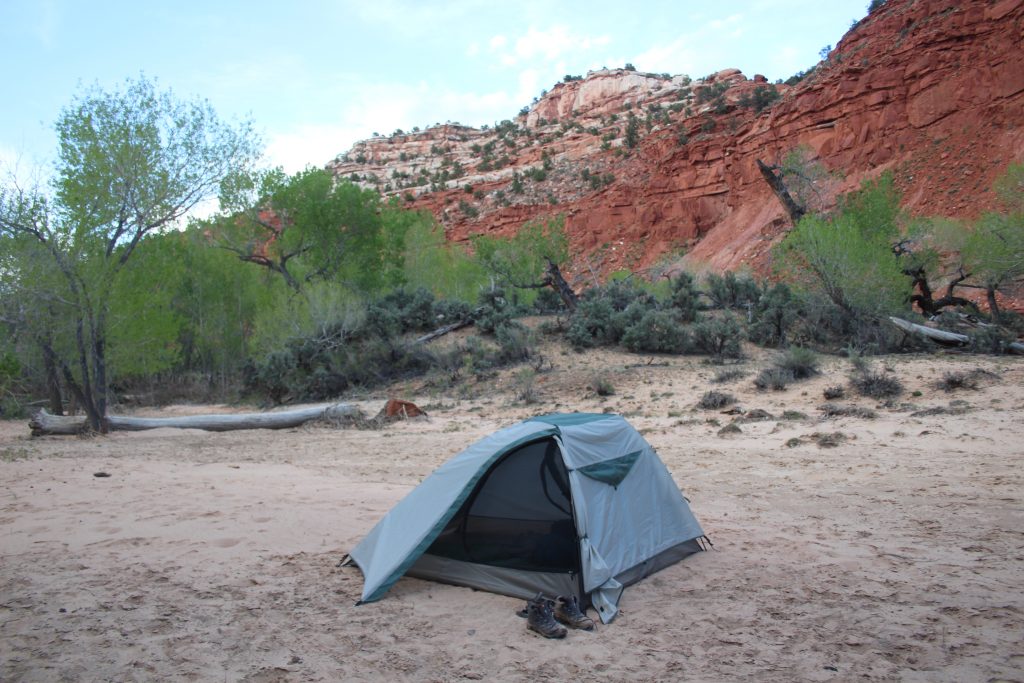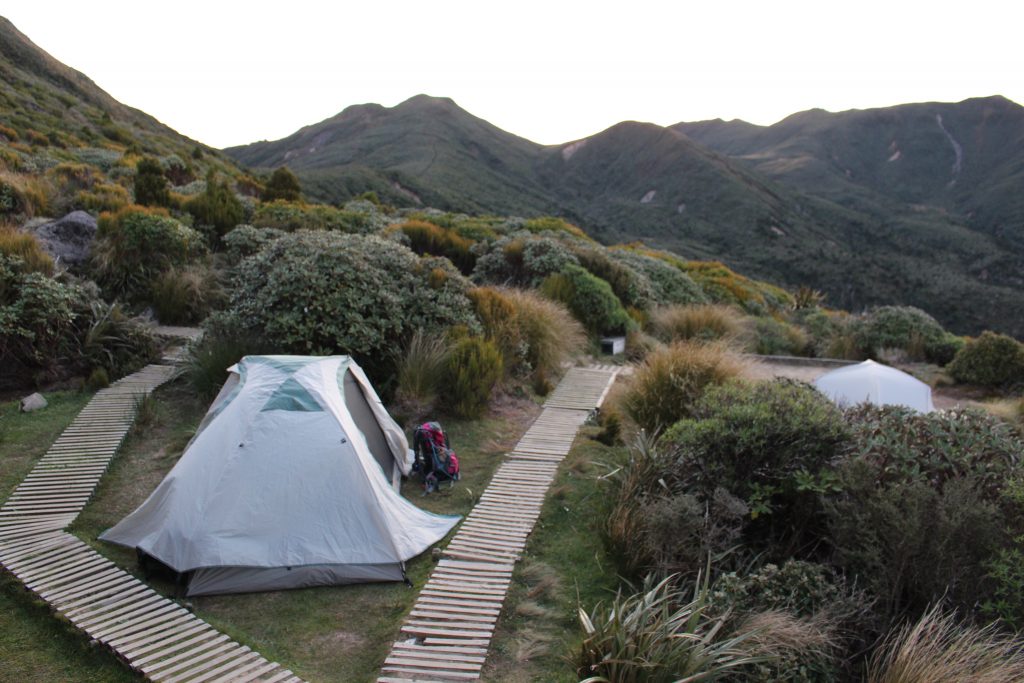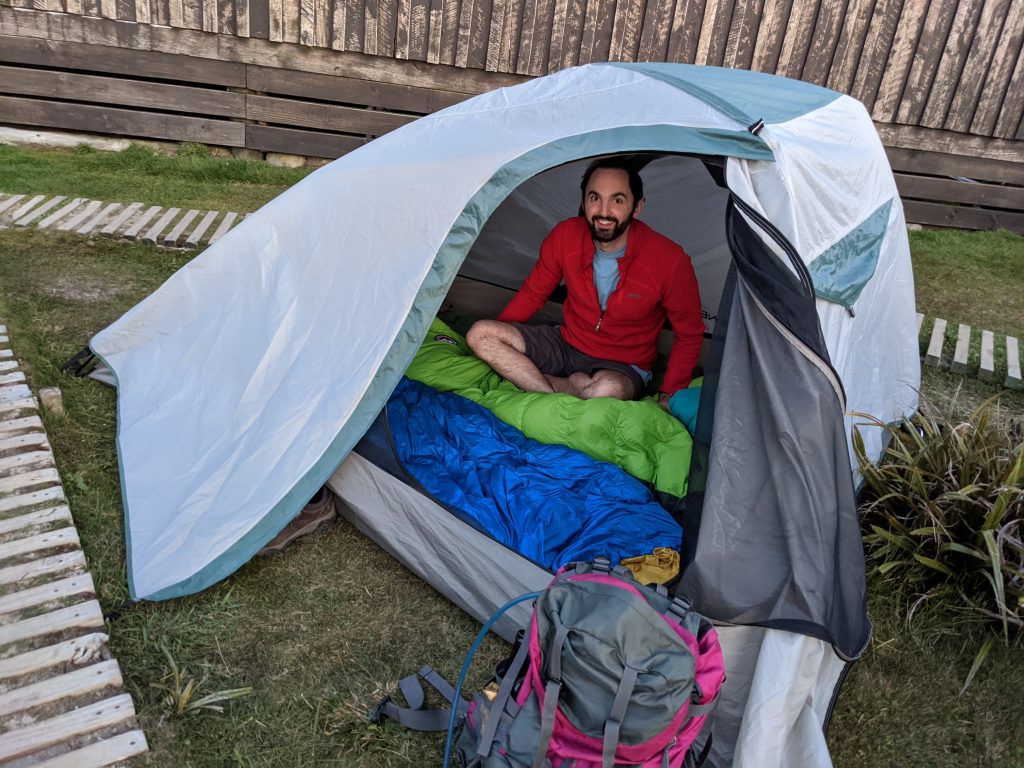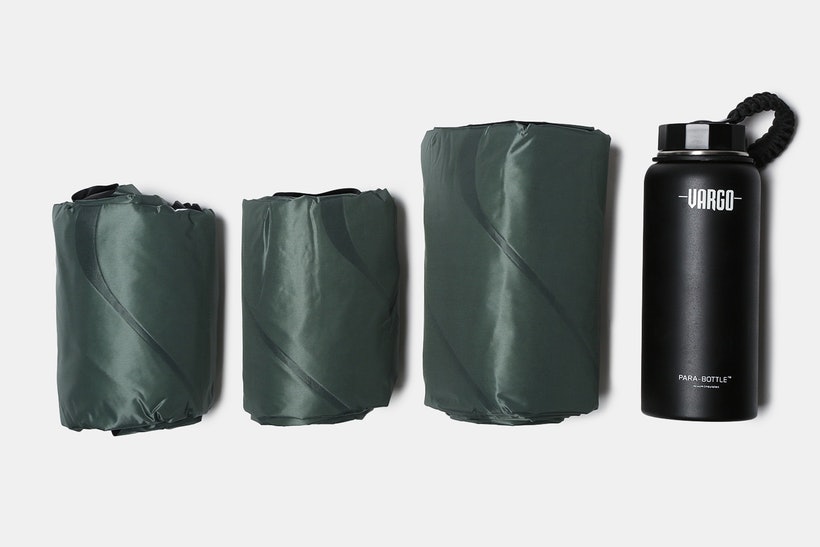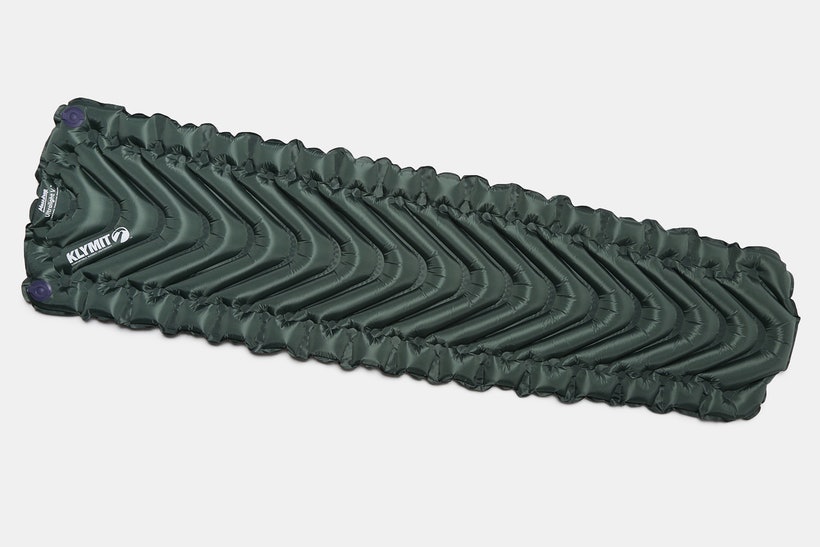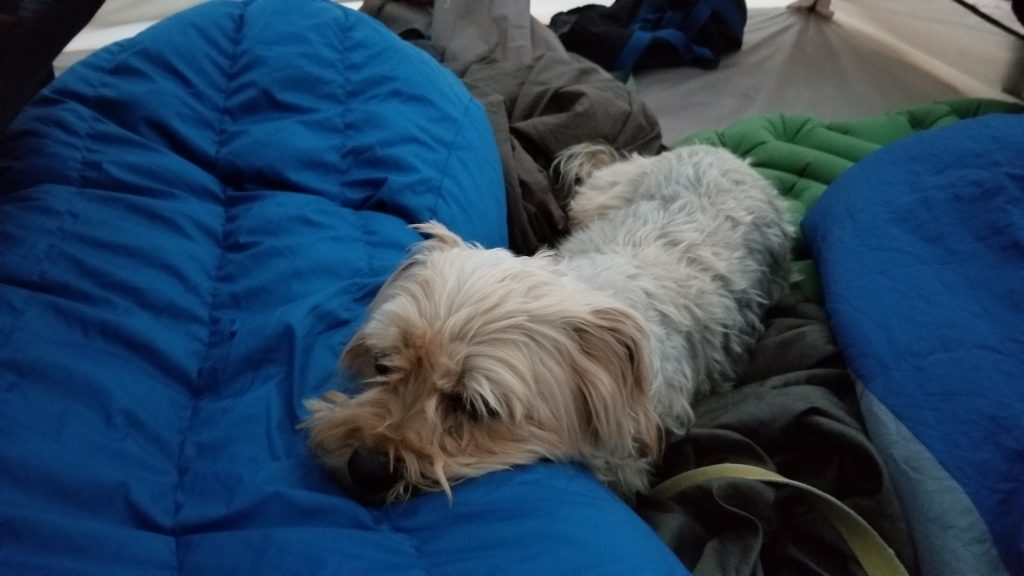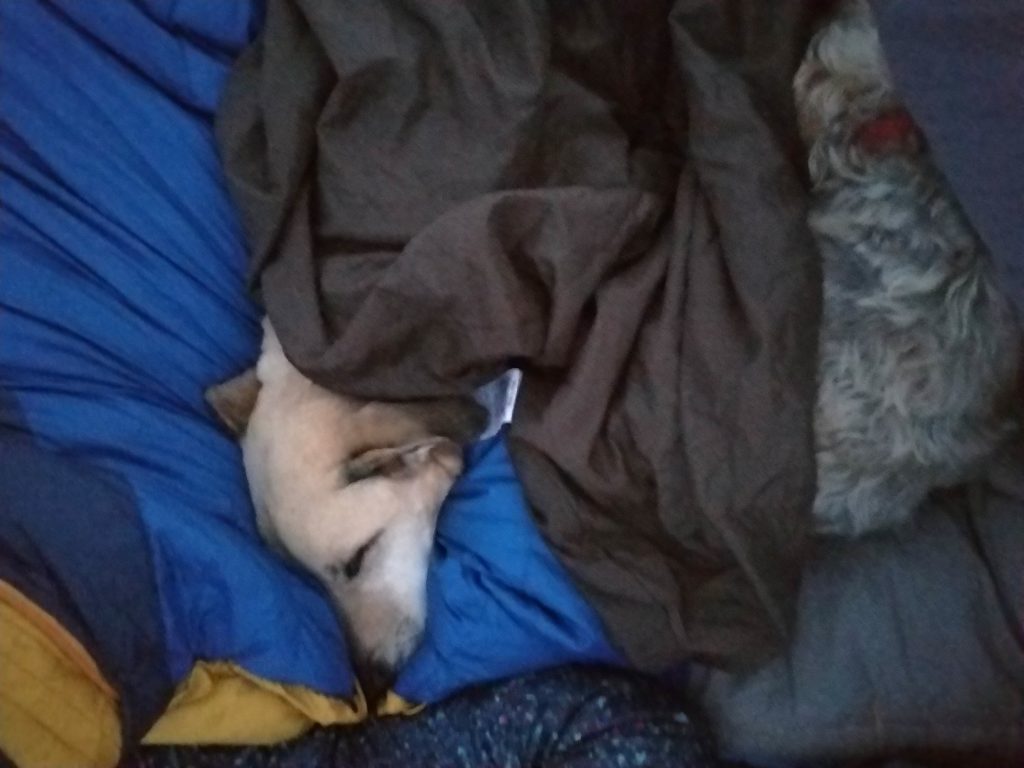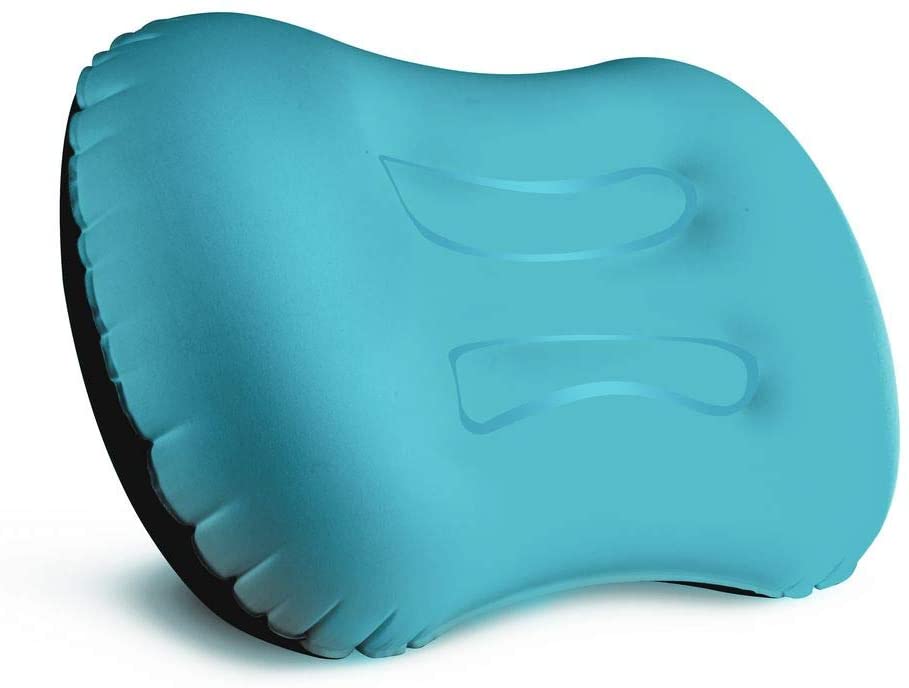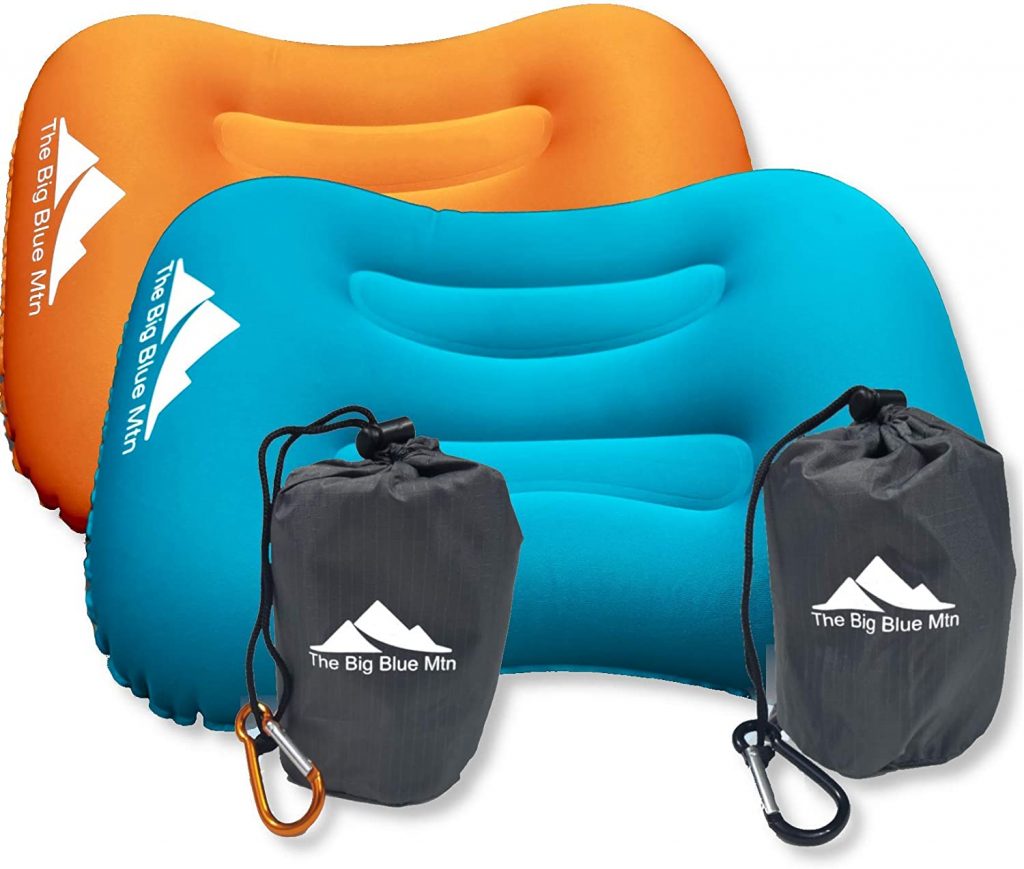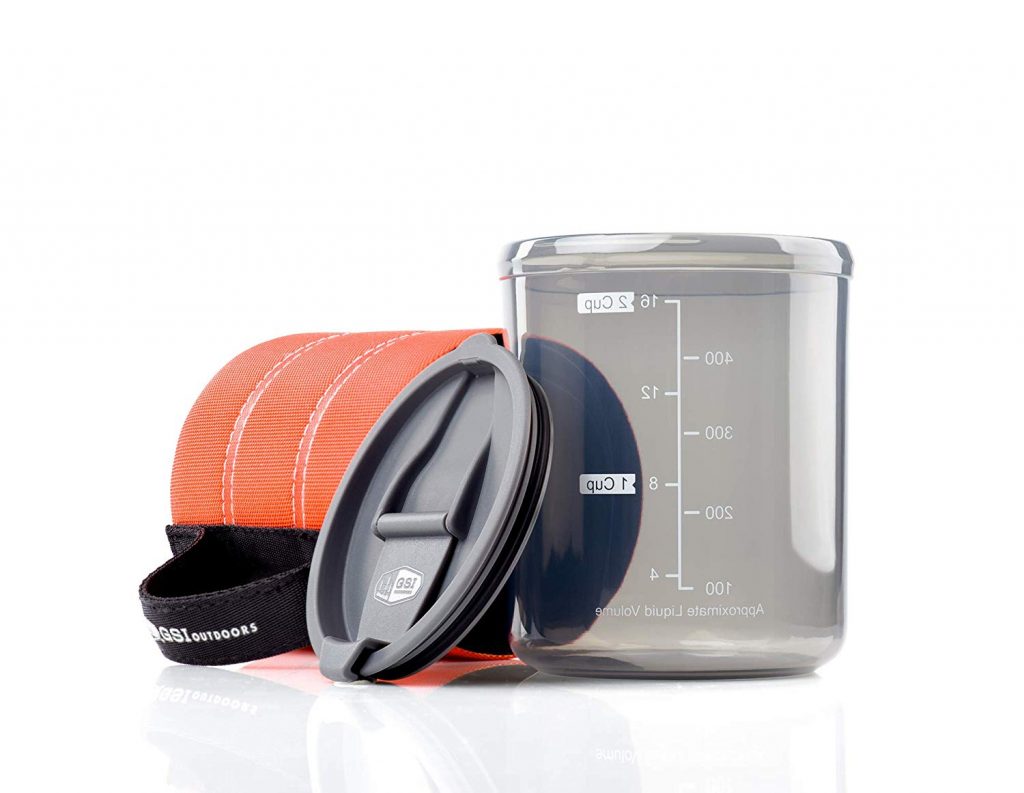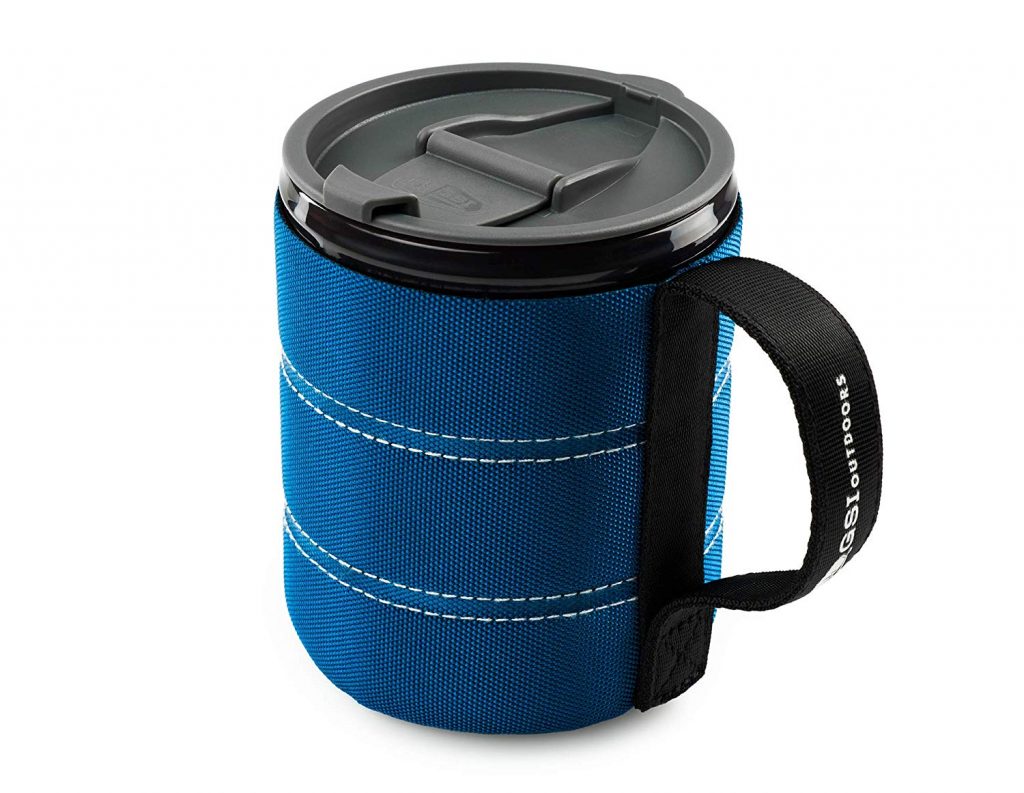A lightweight tent
As far as tents go, there’s no huge rhyme or reason to it. What might work for me, might not be best for you. That being said, I’ll call out the tents I have and the features that I really appreciate in them.
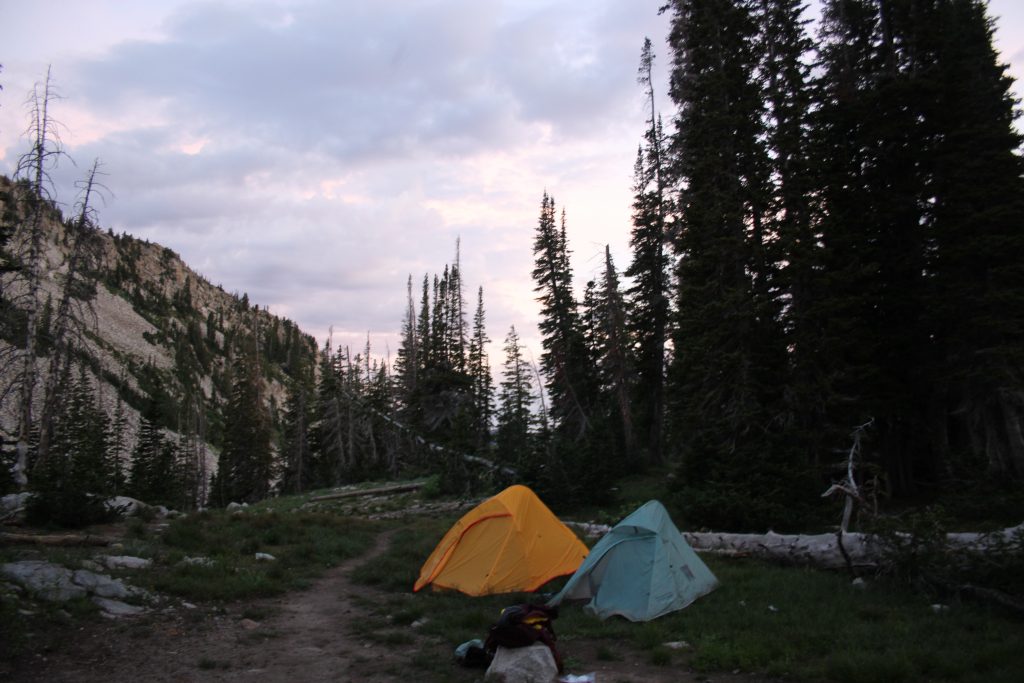
The Wilderness Tech 1.5person tent
I love this tent for solo missions or if it’s just me and the dogs. (It definitely wouldn’t fit 2 people, but it’s much more spacious than a standard 1 man tent, hence the 1.5) It’s incredibly lightweight at only 2.5 lbs, durable, and setups easily in under 5 minutes. My favorite features of this tent are:
- Less mesh on the side walls- this is great if you are in the desert in windy conditions to keep sand out of your tent. The top still offers plenty of ventilation in hot weather, and it stays warmer in cold weather.
- Single pole setup- This thing is easy to setup in any conditions. It uses a single pole and clips to attach the tent body instead of tent sleeves.
- It’s sturdy without needing tie downs. There are great LW tents on the market that only use trekking poles, or 2 vertical poles, but they require the ground to be soft enough to stake out lots of tie downs.
- It can be even lighter if you leave all but 4 stakes and the tent fly at home.
- It’s very weather proof and durable. I once had it setup in the middle of downpours in the desert and with the rainfly attached no water got in, despite literally having a small stream of water running under it all day.
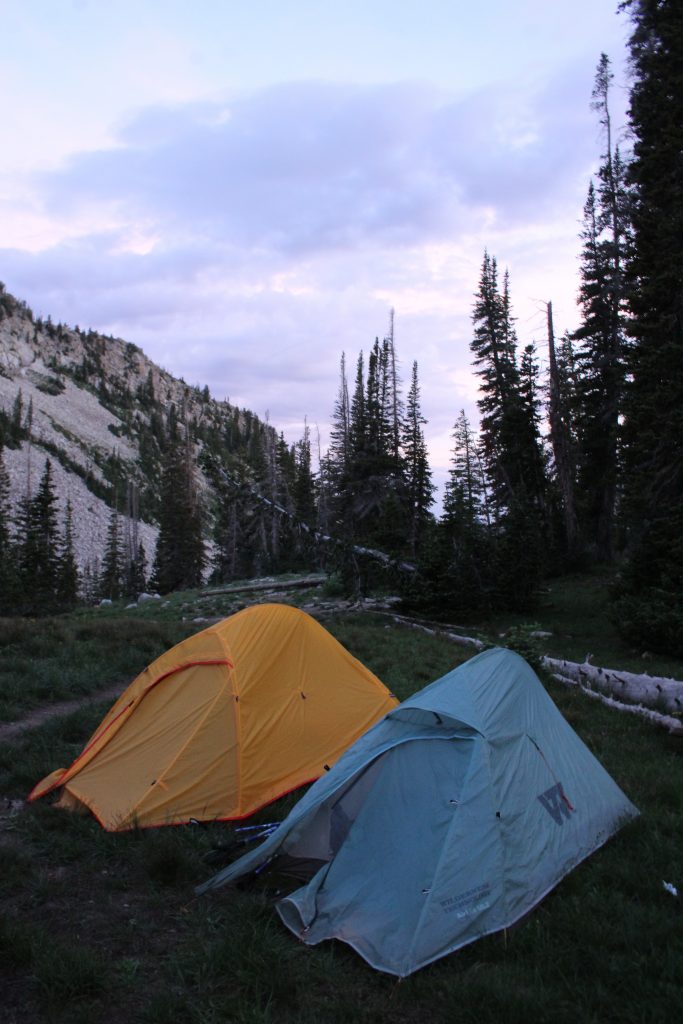
Features I wish it had:
- More storage pockets to keep things organized along the floor of the tent
Alps Mountaineering 3 person tent
I love this tent when I backpack with my partner and our dogs. It is SO spacious without being much heavier than other 2 person tents on the market. We easily fit ourselves and some gear by our feet with our dogs on there plush beds in the middle. (our dogs refuse to sleep down near feet so having space in the middle is a huge positive) It weighs in at just over 5lbs. (if you leave most of the stakes at home) and has proven to be very durable in windy conditions. My favorite features about this tent are:
- SO MUCH SPACE. If you like to backpack with your partner and bigger dogs, this tent is totally the way to go. The floor span itself (40 Sq feet) is more than double my 1.5 person tent and so much better than the standard 2 person backpacking tent (around 29 square feet) The amount of headroom is also a great mention here.
- Double doors- If you are using your tent for 2+ people, make sure to pick a tent that has 2 doors. It makes life so much easier for getting in and out of your tent.
- Great vestibule space for additional gear or leaving muddy shoes outside.
- Good storage at the floor and fabulous gear shelf hanging at the top of the tent for lighter-weight options.
- All mesh siding makes it great in hot weather and super easy to clean
- Easy to setup solo in under 5 minutes.
- Doesn’t rely on tie downs if you’re camped on hard ground. Decently sturdy floor base too if you don’t want to lug a footprint.
Features I’m less stoked about:
- The all mesh sides mean I typically want the rain fly for privacy and wind protection in the tent.
- The tent stakes aren’t very light weight and could be replaced with lighter options.
Klymit Sleeping Pad
If you’re in the market for a new sleeping pad- Klymit is hands down the way to go. As far as I’m concerned, they can do no wrong as I’ve been using my Klymit static V (original) for over 4 years now with no problems. I think the v pockets are ultra-comfortable and great even for side and stomach sleepers. The pads are super lightweight and compact as well so you don’t have a goofy foam pad hanging off your pack. Bonus is they are quiet when rolling around on them! Lots of sleeping pads from other brands (I’m looking at you therma rest) make crinkly sounds when you move on them. I also have an insulated UL version of the static V that’s a bit smaller and more narrow than the original but great for insulation. Things to keep in mind when buying a klymit pad:
- R Value. SO important if you plan on camping early spring/ late Fall or even winter. The basic static V has a VERY low R value which makes it lw and cheaper, but does NOTHING to keep you warm off the ground. That being said, I love it in the summer and when car camping, I just bring an additional foam pad to insulate under it.
- Sizing- Klymit does offer short vs. long options, and super lightweight vs. standard. Make sure you are comfortable with what size you are getting and remember that a good nights sleep might be worth the 5 oz of extra weight to get the wider pad.
LW Sleeping bag rated to at least 15 degrees
While I feel like most camp gear you can invest less in (aka don’t need to spend hundreds on a tent or pad) the sleeping bag could make a world of difference in your total sleep experience. Which is why I definitely recommend finding one that completely satisfies what you need for great sleep. In my case, my perfect bag was found in the Big Agnes Lost Ranger 15. The features I LOVE about this bag are:
- It has a semi-rectangular shape. Since I can only sleep on my stomach or side, traditional mummy bags are miserable for me. However in this bag I’ve got plenty of room to roll from side to side and it keeps me warm even with the extra space.
- It’s very packable and a fantastic weight for its shape. *
- It is made with responsibly sourced down- making it feel warmer and lighter than similar synthetic bags.
- The nylon is SO luxurious. It is so soft and smooth, that between the draft tubes (another must in a good bag) and extra space, I feel like I’m sleeping under a quality down quilt which makes it feel more like a bed, and less like camping.
- It has a pocket to hold your sleeping pad in place underneath you so you remain comfortably on your pad all night long. (The pad pocket can fit both of my klymit pads just fine)
* Note: This bag does not provide ANY insulation under you. You will need a sleeping pad with an R value of over 4 in order to use his bag in below freezing conditions. That being said, I have used this bag in 20 degree temps and can attest that with proper pads, it performs great in freezing temps.
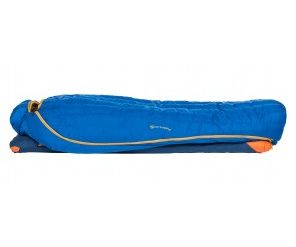
The right pillow
There is no right answer here I’m afraid but I can attest that having SOME sort of pillow is better than nothing. I have tried the clothing stuffed in a bag and covered with a sweater and let me tell you- clothing is NOT that soft when it is condensed in a bag. I have used multiple inflatable pillows and recommend one with this shape as it works best for me.
Jet boil
A lightweight camp stove is a MUST for backpacking trips. There is nothing that beats having a hot meal at the end of a grueling 10+ mile day or waking up to hot coffee on a chilly morning at camp. While there are many LW stoves out there on the market, the jetboil is my favorite choice. It’s great features include:
- Self ignition- mine worked flawlessly for 3+ years until a very sandy trip took it out. Now I just have a small lighter than I bring along just in case it wont get started.
- Its design will boil a cup of water in under a minute. It’s very fast and efficient meaning you need less gas.
- It’s insulated and covered with an easy pour lid as well as indicator on the side to let you know when the water is boiling. Again this means you don’t boil water long than needed preserving gas and getting to that Lasagna meal that much faster.
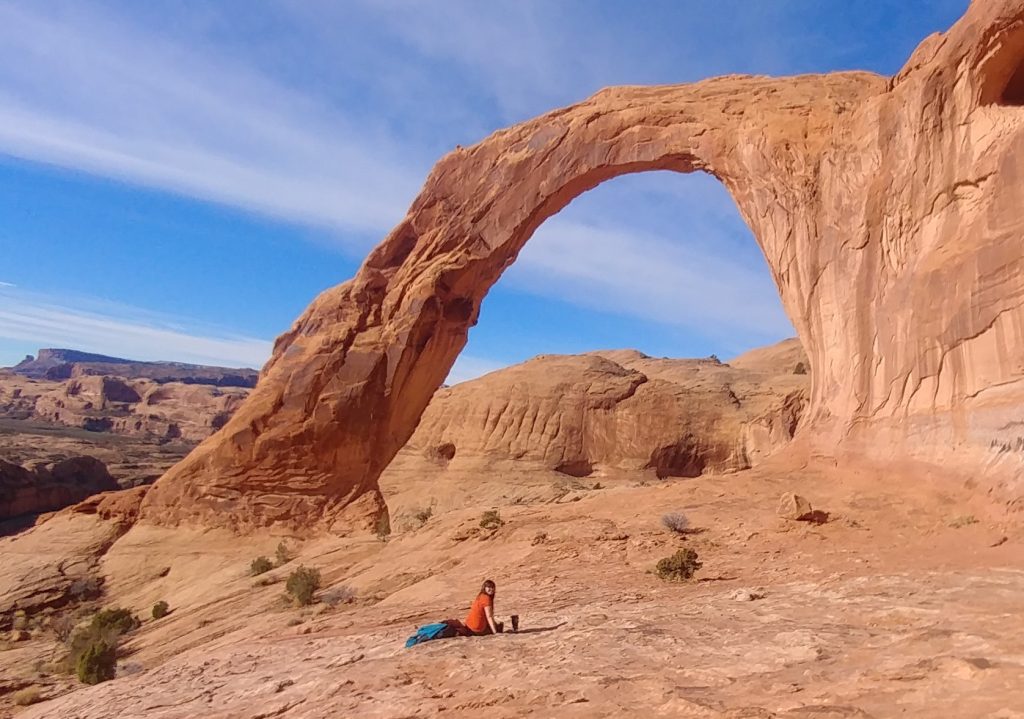
Long titanium spoon
Whatever utensil you buy, make sure it has a long handle if you plan on using dehyrdated meals. This is because those bags are so deep that you end up having to dip your hand into the bag if the handle isn’t long enough to eat the entire thing. (I prefer not to get whatever I am eating all over my hands). As far as meals go, I have yet to meet anything my titanium spoon couldn’t handle. I have this one
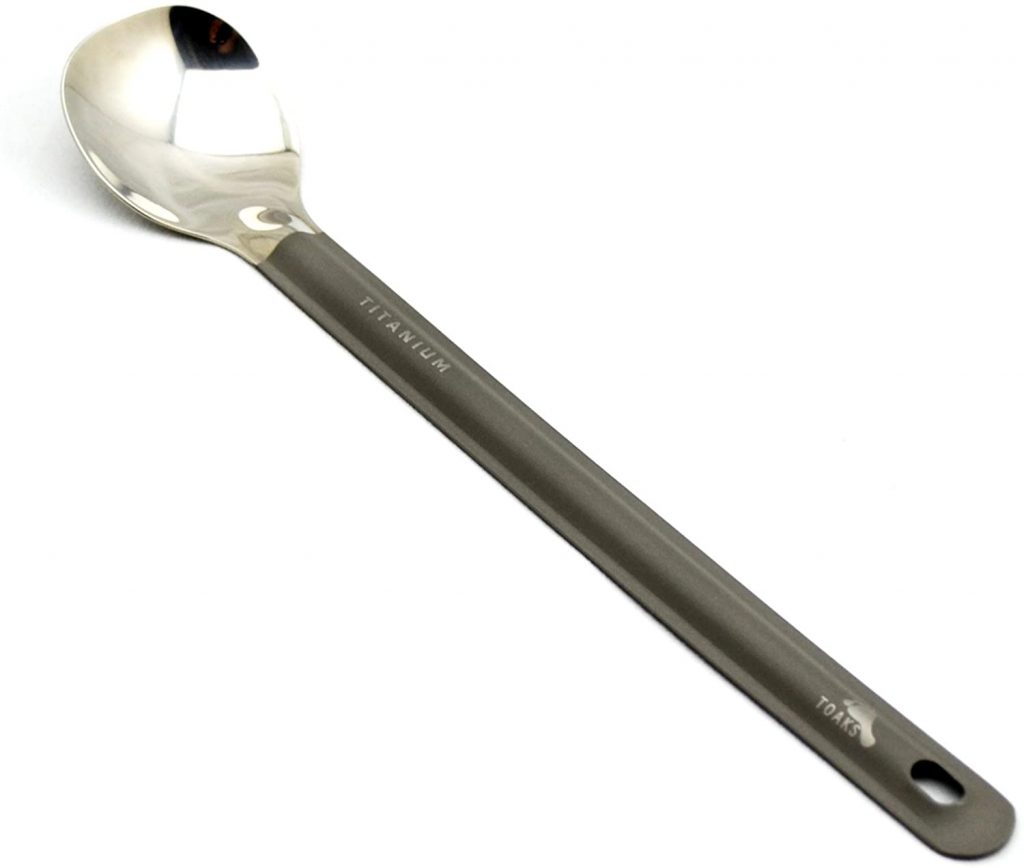
LW Camp Mug
Camp Mugs are an absolutely essential part of backpacking- I use it for the morning cup of joe and for making mixed drinks in the evening (hello lightweight drink options) My favorite mug I’ve tried is the GSI Infinity mug which is very inexpensive, easy to clean, well insulated for hot or cold, and has lid and handle without adding much weight.
Water Filter
There are 2 different filters I recommend based on the type of trip you are taking:
- The Platypus gravity 6L filter: This filter is great if you have a larger group backpacking and sharing the one filter. It filters large quantities of water very quickly and easily. HOWEVER beware that like all gravity filters, don’t filter heavily silted water as it will clog the filter. It works best filtering clear running rivers/ streams or from springs. It also beats out competitor Katadyn gravity filter because the filter is located OUTSIDE of the dirty water reservoir.
- The Sawyer Squeeze filter: This filter works great for 1-2 person trips on quick overnighters. It performs better than a gravity filter when it comes to silty water (though you still want to filter clear water when you can), is still a quick option and easier to troubleshoot. Its hangups come from weak reservoirs under pressure so it’s a good idea to bring back ups. This filer is also much more AFFORDABLE than other filters making it a great beginner filter.
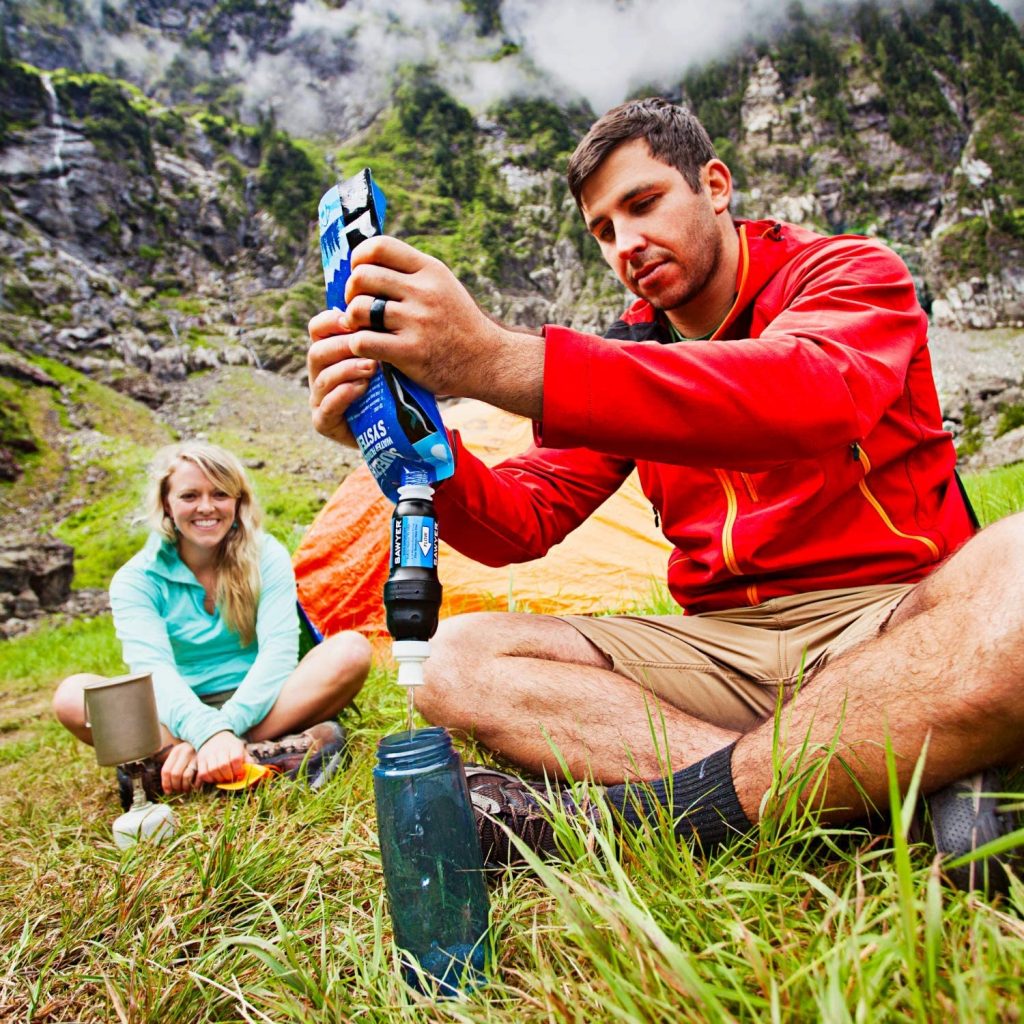
*I always recommend (from several lessons learned) to bring backup water treatment to your filters. I’ve had 1-2 trips where a water filter (I’m looking at you kataydn…) failed. I’d recommend the water treatment drops to straight iodine tablets as some people have side effects from drinking iodine treated water.
Trekking poles
I know several people who have tried trekking poles and decided it wasn’t for them and that used to be the case for me as well- however the more I used them, the more helpful I realized they were. (*on a flat hike, I agree they really don’t help much)
I use my poles equally on the uphill as I do on the downhill. It helps keep my momentum up and even out my pacing so I don’t get out of breath. Poles also greatly help with my stability when carrying a heavy load and help relieve pressure on my toes and knees on the downhill. All that being said- it took me forever to change from my basic snowshoe poles to collapsible trekking poles. Now that I’ve tried them I’ll never go back.
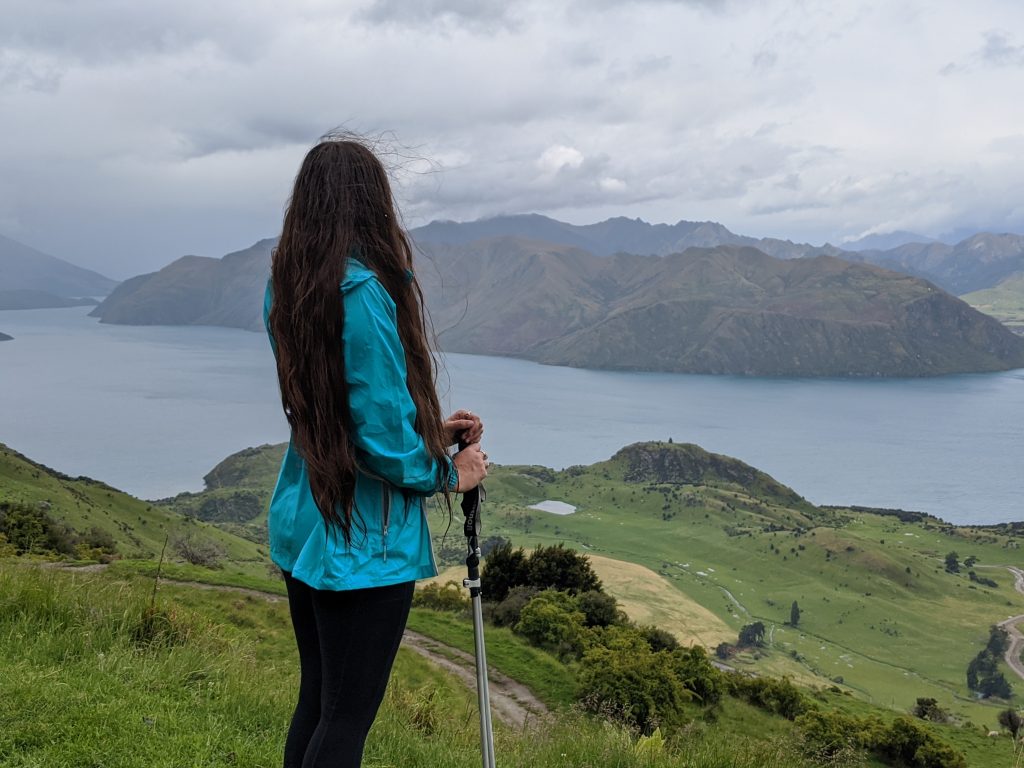
Things to look for in collapsible trekking poles:
- Easy to pack fully collapsible poles – I’ve taken mine to NZ and plan to bring them on a Europe trip this year.
- LW and easy to store options for when not needed on flatter sections of trail
- Cork handles that are more resistant to sweaty/ greasy hands
- DO NOT BUY spin to tighten poles… these almost always fail quickly. Instead look for poles that lock into place with external lockers that you can adjust yourself.
